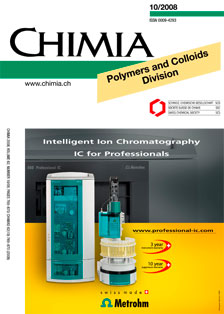Colloidal Drug Delivery Systems – Recent Advances With Polymeric Micelles
DOI:
https://doi.org/10.2533/chimia.2008.832Keywords:
Biodegradable polymers, Block copolymers, Drug delivery, Polymeric micelles, Substituted polylactidesAbstract
With the emergence of nanotechnology in drug delivery, colloidal systems and particularly polymeric micelles have attracted great attention. Polymeric micelles formed by the self-assembly of amphiphilic copolymers adopt a core-shell structure, which can be loaded with drugs and used as drug delivery systems for various medical applications. The most interesting aspects involve extended blood circulation times and stability upon dilution, which enable polymeric micelles to accumulate in tumor or inflammation sites due to the enhanced permeation and retention effect (EPR). In the first part of this paper polymeric micelles with different morphologies and different circulating-, active- and passive targeting, and stimuli responsive properties will be reviewed. Furthermore amphiphilic block copolymers of different compositions for pharmaceutical micelle formulations will be discussed. The hydrophilic block is often composed of the biocompatible polyethylene glycol (PEG), whereas diverse polymers are used for the hydrophobic block. The biodegradable and biocompatible polylactide (PLA) is one of the most tested core-forming blocks for micelles, in part because of approval by the FDA for numerous drug products for use in humans. However, PLA has limitations with respect to the incorporation of poorly water-soluble drugs. Considering this we will present in the second part of this paper briefly our strategy and contribution to overcome these limitations and recent results for the envisioned application of these micelles in the field of cancer treatment. In order to increase the hydrophobicity of PLA methyl groups are substituted by more hydrophobic hexyl groups. The hexyl-substituted polylactides in combination with PEG form the amphiphilic block copolymers PEG-hexPLA, which self-assemble in aqueous solution into stable spherical, homogenous micelles with a diameter of 20–45 nm. The increased hydrophobicity of the hexPLA micelle core leads to higher incorporation rates of hydrophobic drugs, like the poorly water soluble photosensitizer, meso-tetra(p-hydroxyphenyl)porphine (THPP). THPP water solubility is increased 200-fold using these micelles. Their application in photodynamic therapy (PDT), coupled with the increased accumulation of the photosensitizer in a tumor, followed by irradiation at a special wavelength, should lead to tumor death. The encouraging drug incorporation results reveal the potential of hexyl-substituted polylactide micelles as drug carriers for PDT applications.Downloads
Published
2008-10-29
Issue
Section
Scientific Articles
License
Copyright (c) 2008 Swiss Chemical Society

This work is licensed under a Creative Commons Attribution-NonCommercial 4.0 International License.
How to Cite
[1]
K. Mondon, R. Gurny, M. Möller, Chimia 2008, 62, 832, DOI: 10.2533/chimia.2008.832.







